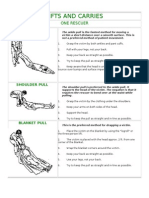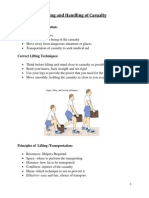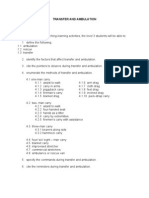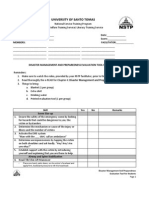First Aid Final Project
First Aid Final Project
Uploaded by
Jheann lojaCopyright:
Available Formats
First Aid Final Project
First Aid Final Project
Uploaded by
Jheann lojaCopyright
Available Formats
Share this document
Did you find this document useful?
Is this content inappropriate?
Copyright:
Available Formats
First Aid Final Project
First Aid Final Project
Uploaded by
Jheann lojaCopyright:
Available Formats
This is the preferred method for
dragging a victim.
BLANKET PULL Place the victim on the blanket
by using the “logroll” or the
three-person lift.
The victim is placed with the
head approx. 2 ft. from one
corner of the blanket.
Wrap the blanket corners
around the victim.
Keep your back as straight as
possible.
Use your legs, not your back.
Try to keep the pull as straight
and in-line as possible.
The shoulder pull is preferred to the
ankle pull. It supports the head of the
SHOULDER PULL victim. The negative is that it requires
the rescuer to bend over at the waist
while pulling.
Grasp the victim by the
clothing under the shoulders.
Keep your arms on both sides
of the head.
Support the head.
Try to keep the pull as straight
and in-line as possible.
The ankle pull is the fastest method
ANKLE PULL for moving a victim a short distance
over a smooth surface. This is not a
preferred method of patient
movement.
Grasp the victim by both
ankles or pant cuffs.
Pull with your legs, not your
back.
Keep your back as straight as
possible.
Try to keep the pull as straight
and in-line as possible.
Keep aware that the head is
unsupported and may bounce
over bumps and surface
imperfections.
ONE-PERSON LIFT This only works with a child or a
very light person.
Place your arms under the
victim’s knees and around
their back.
This technique is for carrying a
FIREFIGHTER CARRY victim longer distances. It is very
difficult to get the person up to
this position from the ground.
Getting the victim into position
requires a very strong rescuer or
an assistant.The victim is carried
over one shoulder.
The rescuer’s arm, on the side
that the victim is being carried,
is wrapped across the victim’s
legs and grasps the victim’s
opposite arm.
When injuries make the firefighter
PACK-STRAP CARRY carry unsafe, this method is better
for longer distances than the one-
person lift.
Place both the victim’s arms
over your shoulders.
Cross the victim’s arms,
grasping the victim’s opposite
wrist.
Pull the arms close to your
chest.
Squat slightly and drive your
hips into the victim while
bending slightly at the waist.
Balance the load on your hips
and support the victim with
your legs.
For the conscious victim, this carry
HUMAN CRUTCH/TWO-PERSON DRAG allows the victim to swing their leg
using the rescuers as a pair of
crutches. For the unconscious victim,
it is a quick and easy way to move a
victim out of immediate danger.
Start with the victim on the
ground.
Both rescuers stand on either
side of the victim’s chest.
The rescuer’s hand nearest the
feet grabs the victim’s wrist on
their side of the victim.
The rescuer’s other hand
grasps the clothing of the
shoulder nearest them.
Pulling and lifting the victim’s
arms, the rescuers bring the
victim into a sitting position.
The conscious victim will then
stand with rescuer assistance.
The rescuers place their hands
around the victim’s waist
For the unconscious victim, the
rescuers will grasp the belt or
waistband of the victim’s
clothing.
The rescuers will then squat
down.
Place the victim’s arms over
their shoulders so that they
end up facing the same
direction as the victim.
Then, using their legs, they
stand with the victim.
The rescuers then move out,
dragging the victim’s legs behind.
This technique is for carrying
FOUR-HANDED SEAT conscious and alert victims moderate
distances.
The victim must be able to
stand unsupported and hold
themselves upright during
transport.
Position the hands as indicated
in the graphic.
Lower the seat and allow the
victim to sit.
Lower the seat using your legs,
not your back.
When the victim is in place,
stand using your legs, keeping
your back straight.
This technique is for carrying a victim
TWO-HANDED SEAT longer distances. This technique can
support an unconscious victim.
Pick up the victim by having
both rescuers squat down on
either side of the victim.
Reach under the victim’s
shoulders and under their
knees.
Grasp the other rescuer’s
wrists.
From the squat, with good
lifting technique, stand.
Walk in the direction that the
victim is facing.
This is a good method for carrying
victims up and down stairs or
CHAIR CARRY through narrow or uneven areas.
NOTE: The chair used should be a
sturdy one. Don’t use aluminum
beach chairs, resin patio chairs,
swivel chairs, or lightweight folding
chairs.
REMEMBER: Chairs with wheels can
be used to roll the victim, but should
not be used for a carry.
Pick the victim up and place
them or have them sit in a
chair.
The rescuer at the head grasps
the chair from the sides of the
back, palms in.
The rescuer at the head then
tilts the chair back onto its rear
legs.
For short distances or
stairwells, the second rescuer
should face in and grasp the
chair legs.
For longer distances, the
second rescuer should
separate the victim’s legs, back
into the chair and, on the
command of the rescuer at the
head, both rescuers stand
using their legs.
This technique requires two
IMPROVISED STRETCHER poles/pipes strong enough to
support the victim’s weight and at
least two shirts.
REMEMBER: Rescuers should not
give up clothing if, for any reason,
this might affect their health,
welfare, or reduce their
effectiveness.
While the first rescuer is
grasping the litter poles, the
second rescuer pulls the shirt
off the head of rescuer one.
All buttons should be buttoned
with the possible exception of
the collar and cuffs.
The rescuers then reverse the
procedure and switch sides.
This technique requires two poles
BLANKET STRETCHER and a blanket.
Place the blanket down on the
ground.
Place one pole approx. 1 foot
from the middle of the
blanket.
Fold the short end of the
blanket over the first pole.
Place the second pole approx.
2 feet from the first (this
distance may vary with victim
or blanket size).
Fold both halves of the blanket
over the second pole.
Three or more rescuers get on both
HAMMOCK CARRY sides of the victim. The strongest
member is on the side with the
fewest rescuers.
Reach under the victim and
grasp one wrist on the
opposite rescuer.
The rescuers on the ends will
only be able to grasp one wrist
on the opposite rescuer.
The rescuers with only one
wrist grasped will use their
free hands to support the
victim’s head and feet/legs.
The rescuers will then squat
and lift the victim on the
command of the person
nearest the head,
remembering to use proper
lifting techniques.
This technique is for lifting a patient
THREE-PERSON CARRY OR STRETCHER LIFT into a bed or stretcher, or for
transporting them short distances.
Each person kneels on the
knee nearest the victim’s feet.
On the command of the
person at the head, the
rescuers lift the victim up and
rest the victim on their knees.
If the patient is being placed
on a low stretcher or litter
basket:
On the command of the
person at the head, the patient
is placed down on the
litter/stretcher.
If the victim is to be placed on
a high gurney/bed or to be
carried:
At this point, the rescuers will
rotate the victim so that the
victim is facing the rescuers,
resting against the rescuers’
chests.
On the command of the
person at the head, all the
rescuers will stand.
To walk, all rescuers will start
out on the same foot, walking
in a line abreast.
FINAL ACTIVITY
IN PATHFIT 3
Submitted By:
Salem, Jaynor S.
Submitted To:
Ms, Carmela Lovero
January 25, 2025
You might also like
- Geek Girl by Holly Smale ExtractDocument26 pagesGeek Girl by Holly Smale ExtractAnonymous ikUR753am62% (13)
- Hunger Games Reaping Scene Screenshots and AnalysisDocument9 pagesHunger Games Reaping Scene Screenshots and AnalysisNiamh Sygrove100% (1)
- Emergency Carry TechniquesDocument37 pagesEmergency Carry Techniquesjojo ramirez0% (1)
- Transportation of The InjuredDocument25 pagesTransportation of The InjuredPrecilla C. Stephen100% (6)
- Disaster Nursing LaboratoryDocument8 pagesDisaster Nursing Laboratoryshanepaguirigan01No ratings yet
- A. Different Techniques and Types of LiftingDocument18 pagesA. Different Techniques and Types of LiftingLanzen DragneelNo ratings yet
- Victims EvacuationDocument20 pagesVictims EvacuationKian AlfrzNo ratings yet
- Carrying The VictimDocument5 pagesCarrying The VictimTchaikovsky AyopNo ratings yet
- Lift and CarriesDocument25 pagesLift and CarriesJohn Dan FerreriaNo ratings yet
- 3 and 4 of Fundamentals of First Aid ModuleDocument27 pages3 and 4 of Fundamentals of First Aid ModuleMark Joseph P. GaniaNo ratings yet
- Transfer TechniqueDocument30 pagesTransfer Techniquedrei yanNo ratings yet
- Mapeh 9Document8 pagesMapeh 9Angelica Francine GuanlaoNo ratings yet
- Lifts and CarriesDocument7 pagesLifts and CarriesDel Mabel100% (1)
- NSTP Assg. #3Document4 pagesNSTP Assg. #3Jeanette FormenteraNo ratings yet
- LAS MAPEH 9 Q3 W6 HealthDocument6 pagesLAS MAPEH 9 Q3 W6 HealthJemalyn Hibaya LasacaNo ratings yet
- Moving A VictimDocument16 pagesMoving A VictimMarian Drew Parcon LopezNo ratings yet
- Victim Evacuation/Casualties Handling Manual TechniquesDocument9 pagesVictim Evacuation/Casualties Handling Manual TechniquesNOr JOeNo ratings yet
- Health9-Module2 Q3Document10 pagesHealth9-Module2 Q3ExequielNo ratings yet
- First AidDocument8 pagesFirst AidMe'an GaganNo ratings yet
- Emergency Rescue Transfer RevisedDocument45 pagesEmergency Rescue Transfer RevisedZionNo ratings yet
- Bandages and TransportationDocument48 pagesBandages and TransportationYuko KomatsuNo ratings yet
- First AidDocument26 pagesFirst AidNicole SarmientoNo ratings yet
- Las Ro3 Final h9q3w4 8Document17 pagesLas Ro3 Final h9q3w4 8Ian Santos B. SalinasNo ratings yet
- Lifting and Handling of Casualty HandoutsDocument6 pagesLifting and Handling of Casualty HandoutsIvy Jorene Roman RodriguezNo ratings yet
- HealthDocument5 pagesHealthMaze GomezNo ratings yet
- Transfer and AmbulationDocument15 pagesTransfer and AmbulationpleburNo ratings yet
- Three Four Man CarryDocument21 pagesThree Four Man CarryShiela CorderoNo ratings yet
- 1 Aids-321-346Document26 pages1 Aids-321-346Ehtesham AkhtarNo ratings yet
- Swimming Techniques 6 Slides Per PageDocument11 pagesSwimming Techniques 6 Slides Per PageJohn Nicole CortezNo ratings yet
- SCRIPT_RESCUING&MOVINGDocument7 pagesSCRIPT_RESCUING&MOVINGNadia AzzahraaNo ratings yet
- Lesson 14 Transport A Casualty Using A Two-Man Carry or An Improvised LitterDocument54 pagesLesson 14 Transport A Casualty Using A Two-Man Carry or An Improvised LittersrtmedicNo ratings yet
- First Aid NotesDocument13 pagesFirst Aid NotesVian ArccenioNo ratings yet
- Lifts and Carries PowerpointDocument68 pagesLifts and Carries Powerpointpaul67% (3)
- Techniques For Moving An Injured or Ill Person PDFDocument3 pagesTechniques For Moving An Injured or Ill Person PDFMidi RiyantoNo ratings yet
- Emergency Rescue and Transfer HardDocument5 pagesEmergency Rescue and Transfer HardJorhally B Edzraphil100% (2)
- Transportationofinjured 210427074259Document33 pagesTransportationofinjured 210427074259Nikki LacuarinNo ratings yet
- Emergency Transfer and CarriesDocument10 pagesEmergency Transfer and CarriesLoord Vie Lu Mondigo100% (1)
- NCM 121 Skills MidtermDocument5 pagesNCM 121 Skills MidtermShiehan Mae ForroNo ratings yet
- 6.1. Carry The VictimDocument12 pages6.1. Carry The VictimEkin ShekinNo ratings yet
- 2 Man CarryDocument3 pages2 Man CarryEniryz M. SalomonNo ratings yet
- First Aid With LAF DR - IndahDocument32 pagesFirst Aid With LAF DR - IndahIndah Triayu IriantiNo ratings yet
- Ambrocio Poline Lovers CarryDocument1 pageAmbrocio Poline Lovers CarryYanagidaNo ratings yet
- Transporting An InjuredDocument20 pagesTransporting An InjuredpriyaNo ratings yet
- DRM Tool For StudentsDocument6 pagesDRM Tool For StudentsTricia PrestozaNo ratings yet
- Final Demo DLPDocument10 pagesFinal Demo DLPJohn DavidNo ratings yet
- Rescue and Carry Methods Power PointDocument75 pagesRescue and Carry Methods Power PointJean Minette Prado88% (8)
- First Aid Transportation of The InjuredDocument30 pagesFirst Aid Transportation of The InjuredMuhammad Naveed Akhtar100% (1)
- 69 - Lesson 3 z33dTfDocument6 pages69 - Lesson 3 z33dTfJohn Ace MataNo ratings yet
- Prioritization and CarryingDocument8 pagesPrioritization and CarryingJordan ChavezNo ratings yet
- Lifting and Moving PatientsDocument48 pagesLifting and Moving PatientsHannah DuyagNo ratings yet
- Rollbord With Flat Sheet For Lateral Transfer Instructions - SMGHDocument1 pageRollbord With Flat Sheet For Lateral Transfer Instructions - SMGHAhata Sham NewazNo ratings yet
- Basicfirstaid (Bandaging)Document29 pagesBasicfirstaid (Bandaging)roy rubaNo ratings yet
- Passed-2790-13-21MELCS-Tabuk City - UnintentionalinjuriesDocument17 pagesPassed-2790-13-21MELCS-Tabuk City - Unintentionalinjuriesrangelynrish aguirreNo ratings yet
- Transporting The Victim (Drag and Carry TechniquesDocument9 pagesTransporting The Victim (Drag and Carry TechniquesShiela EjurangoNo ratings yet
- Health: Quarter 3 - Module 5: Techniques in Carrying and Transporting The VictimDocument19 pagesHealth: Quarter 3 - Module 5: Techniques in Carrying and Transporting The VictimNnayz0% (1)
- Emergency Rescue - DocsDocument3 pagesEmergency Rescue - DocsZhavia ShyNo ratings yet
- Techniques of One-Man CarryDocument2 pagesTechniques of One-Man CarryEula EalenaNo ratings yet
- First Aid For Fractures and Sprains & Transport by Archel AntonioDocument38 pagesFirst Aid For Fractures and Sprains & Transport by Archel AntonioarchelNo ratings yet
- Sia Trainer Pi HandoutDocument12 pagesSia Trainer Pi Handoutgarry.scrivens1ntlworld.comNo ratings yet
- Transportation of Injured Person by DR - RESHMA AJAYDocument30 pagesTransportation of Injured Person by DR - RESHMA AJAYDR RESHMA AJAYNo ratings yet
- The Main Locks of Jiu-Jitsu - Including Pictures and Step by Step InstructionsFrom EverandThe Main Locks of Jiu-Jitsu - Including Pictures and Step by Step InstructionsNo ratings yet
- Assignment in CADocument2 pagesAssignment in CAJheann lojaNo ratings yet
- CLJ 1Document11 pagesCLJ 1Jheann lojaNo ratings yet
- The Constitution and by Laws of CJSC SNMCDocument8 pagesThe Constitution and by Laws of CJSC SNMCJheann lojaNo ratings yet
- Administration of Police Organization LEA ReviewDocument10 pagesAdministration of Police Organization LEA ReviewJheann lojaNo ratings yet
- MODULE 1 Lesson 3A The Sexual SelfDocument6 pagesMODULE 1 Lesson 3A The Sexual SelfJheann lojaNo ratings yet
- Week 6 ExcerptsDocument16 pagesWeek 6 ExcerptsJheann lojaNo ratings yet
- Mathematical LogicDocument9 pagesMathematical LogicJheann lojaNo ratings yet
- MODULE 1 Lesson 3B The Political SelfDocument2 pagesMODULE 1 Lesson 3B The Political SelfJheann lojaNo ratings yet
- CRIM 1 - Lesson 2Document3 pagesCRIM 1 - Lesson 2Jheann lojaNo ratings yet
- Week - 4 - Lesson1 & 2Document3 pagesWeek - 4 - Lesson1 & 2Jheann lojaNo ratings yet
- Annex B Learner Survey Form TemplateDocument1 pageAnnex B Learner Survey Form Templaten RNo ratings yet
- Opis ObrazkaDocument1 pageOpis ObrazkaKlaudia KasprzakNo ratings yet
- Notice - New Uniform 2023-24 - 0Document4 pagesNotice - New Uniform 2023-24 - 0shaheenkanizfatmaNo ratings yet
- Review Film CelebrityDocument2 pagesReview Film Celebritys8mvx8v7nvNo ratings yet
- Member Directory Clothing IndustryDocument49 pagesMember Directory Clothing Industrykindhearted19No ratings yet
- Byzantine DressDocument8 pagesByzantine Dressmanil orpanNo ratings yet
- Unit01 Standard TestDocument4 pagesUnit01 Standard TestCarito MoyaNo ratings yet
- How To Describe A PictureDocument17 pagesHow To Describe A PictureCamilo GuerraNo ratings yet
- War of The Handbags - The Takeover Battle For Gucci Group N.V.Document53 pagesWar of The Handbags - The Takeover Battle For Gucci Group N.V.Shonali KapoorNo ratings yet
- Easy Shoe Size Conversion Charts US UK EURODocument1 pageEasy Shoe Size Conversion Charts US UK EUROkaiNo ratings yet
- Buy Aviator Jacket Men From Lindbergh: StyleDocument2 pagesBuy Aviator Jacket Men From Lindbergh: StylePranev KumarNo ratings yet
- GROUP 4 - The Lady and Her Five Suitors' AnnotationsDocument11 pagesGROUP 4 - The Lady and Her Five Suitors' AnnotationstwobrangganNo ratings yet
- KA Esuma Bunko Relay Booklet 2020Document14 pagesKA Esuma Bunko Relay Booklet 2020LirwanNo ratings yet
- Alexander McQueen Business IntroductionDocument6 pagesAlexander McQueen Business Introduction晨航 凌No ratings yet
- DtugjmDocument9 pagesDtugjmalbamunoz206No ratings yet
- Perfume Feminino!: Carolina Herreira 212 Sexy - 100 ML R$ 217,50Document7 pagesPerfume Feminino!: Carolina Herreira 212 Sexy - 100 ML R$ 217,50Thiago MarquesNo ratings yet
- Link L4 U2 Unit TestaDocument2 pagesLink L4 U2 Unit TestaEwelina ZamielskaNo ratings yet
- Paris To New York The Transatlantic Fashion Industry in The Twentieth Century (Véronique Pouillard) (Z-Library)Document336 pagesParis To New York The Transatlantic Fashion Industry in The Twentieth Century (Véronique Pouillard) (Z-Library)lijl.heidyNo ratings yet
- Alucard NowakiDocument3 pagesAlucard Nowakiaydendeleon6203No ratings yet
- ERS84-CATALOGO-201506 GardaDocument446 pagesERS84-CATALOGO-201506 GardaMohammed TaukhirNo ratings yet
- Unit 5Document13 pagesUnit 5Ullas GowdaNo ratings yet
- Case Study: Tailor - LisaDocument2 pagesCase Study: Tailor - LisaFools ParadiseNo ratings yet
- Homes Amp Amp Interiors Scotland May 2023Document246 pagesHomes Amp Amp Interiors Scotland May 2023Ravi KanthNo ratings yet
- FCBO End Term JuryDocument69 pagesFCBO End Term JuryAKSHAY NATHNo ratings yet
- All Orders - SHEIN JJJJDocument7 pagesAll Orders - SHEIN JJJJFrancellys FrancellysNo ratings yet
- Baby's Hat - BonnetDocument6 pagesBaby's Hat - BonnetHoàng LanNo ratings yet
- Under Armour July 2018 Supplier List Disclosure 0Document13 pagesUnder Armour July 2018 Supplier List Disclosure 0sanjanabhatia17No ratings yet
- Rolex Sky-Dweller Blue Dial 42mm - DUBAILUXURYWATCHDocument1 pageRolex Sky-Dweller Blue Dial 42mm - DUBAILUXURYWATCHomarchedliNo ratings yet



































































































